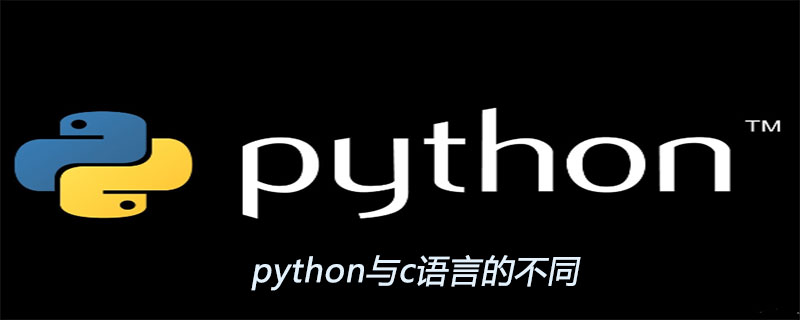Home >Backend Development >Python Tutorial >The difference between python and c language
Python can be said to be one of the hottest languages at present. The rise of artificial intelligence has made Python a household name overnight. Python is known as the easiest and easiest language to learn. Now many colleges and universities have begun to use Python as a freshman. An introductory language for new students. I have just started to come into contact with Python and found that Python is indeed very different from other languages. Python is implemented in C language, so I would like to make a simple comparison between Python and C language.

1.
C language is a compiled language. After compilation, machine code is generated and then run. The execution speed is fast and cannot be cross-platform. Generally used for low-level development of operating systems, drivers, etc.
The boundary between whether Python is compiled or interpreted is not obvious, but it can generally be understood as an interpreted language with slow execution speed. Due to the Python virtual machine, Python can be cross-platform. Python is highly integrated and suitable for Rapid development of software.
2.
The data types of C language are as follows:

In C language, variable types need to be defined in advance to Take the int type as an example. When an int type variable is defined, 4 bytes will be allocated in the memory and then initialized. Since the length is specified, issues such as overflow and accuracy need to be considered during the operation.
Data types in Python:
1.Number: Number
Int
Float
Bool
Complex
2.String: String
3.List: List
4.Tupel: Tuple
5.Sets: Set
6.Dictionary: Dictionary
Python does not need to define the variable type in advance. Take a=3 as an example. Store an integer 3 in the memory, and then use the variable a to point to 3. The variable a has no type. Yes, the type we are talking about refers to the type of the object in memory pointed to by the variable.
You can see the friendliness of Python from the data type. There are fewer basic data types. There are no annoying pointers. There is no need to consider data overflow and precision issues. When a variable needs to be used in the program , it can be used directly without defining the variable at the beginning of the program. In addition, Python also provides powerful data types such as str, list, and dict, making program development easier.
3.
Python also provides an interactive interface. Enter python to enter the interactive interface, enter exit() to exit the interactive interface, similar to a Linux terminal. Enter a line of commands and execute a line for learning. Python provides great convenience.
4.
There is no big difference between the two in terms of operators and precedence, but there are no self-increment and self-decrement operators in Python, and Python also has logical operators. Different from C language, Python is and, or, not, while in C language it is &&, ||,!
6.
In Python, indentation is used to represent the statement body, and C language uses {} to represent the statement body, and there is no semicolon after the end of each statement in Python, judging the statement if else , there is no difference between the two, and there is no loop statement while, just a for loop, Python represents it through for in.
7.
Python has many built-in functions (build in function), so there is no need to write header files. Python also has many powerful modules that can be imported when needed. C language is far inferior to Python in this regard, and most of the time you need to implement it manually.
8.
Functions in C language have strict order restrictions. If you want to call a function, the function needs to be implemented before this call, or declared in advance at the beginning of the program. , but there is no such restriction in Python. There is also the concept of higher-order functions in Python, that is, the function name can also be used as a function parameter. The function name is also a variable that points to a certain function in the memory. This way of writing can greatly Reduce code length.
Python also provides variable parameters and keyword parameters, which greatly improves the function of the function. It used to be necessary to write multiple functions, but now only one function is needed to achieve these functions.
9.
C language is a process-oriented language. Many times, you need to manually implement functions to complete a certain function. Classes and objects are introduced in Python, which is an object-oriented programming language. Object-oriented greatly improves the reusability of code and better encapsulation of data. I won’t go into details about the specific comparison between object-oriented and process-oriented, but there are two very important words: classes are abstract, while objects are concrete.
10.
There are both functions and methods in Python, which often makes people confused. I personally feel that it is not necessary to distinguish clearly, but there is still a big difference between the two: functions are Free, but the method is limited. When programming, you need to distinguish whether you are calling a method or a function.
The above is the detailed content of The difference between python and c language. For more information, please follow other related articles on the PHP Chinese website!